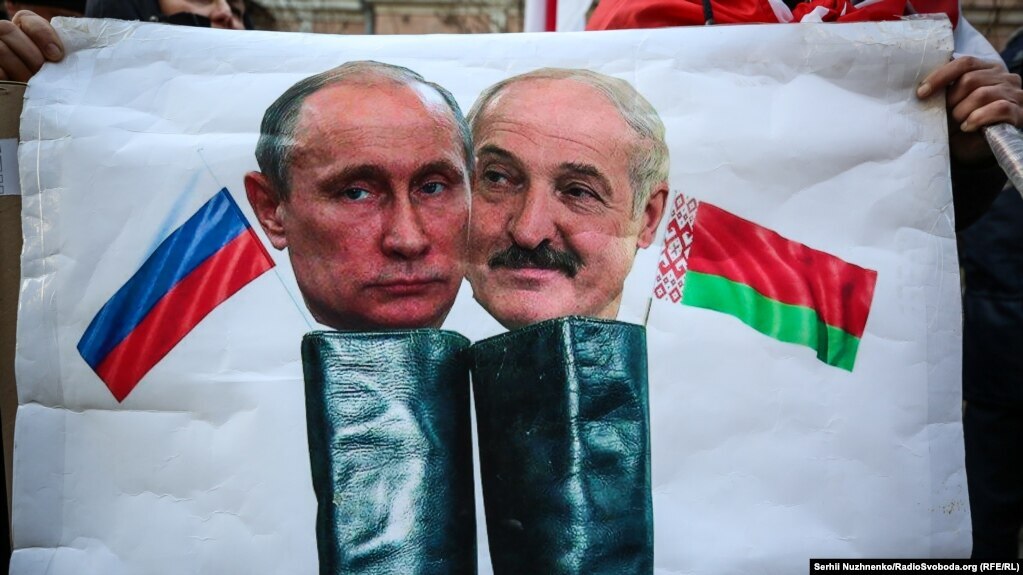2023: growing dependence on Russia; 2024: cultural “takeover” of Belarus by Russia
 The situation got worse
The situation got worse

Putting military-political cooperation aside, the business agenda for Belarusian-Russian relations in 2023 revolved around three interconnected strategies: union building, import substitution, and regional cooperation. While these strategies are not inherently closely linked, they share a common element—the Kremlin’s intention to establish a new world order, with the Union State designated as one of the leading geopolitical centers of power.
In the realm of Belarusian-Russian integration, which had seen little progress over the past 20 years, a significant breakthrough occurred in the last two years. According to Minsk, the package of union programs approved in November 2021 has been nearly completed, with 94% implementation. Twenty-two out of 28 programs have been fully executed, and the remaining ones are at a “high level of readiness” and expected to be completed soon. Furthermore, a draft of a new integration plan has already been prepared, encompassing 120 activities distributed across 11 sections, including the further development of national payment systems, the launch of a unified electricity market, and the advancement of industrial cooperation.
In the past, such dynamics of approvals might have been envied by the European Union and NAFTA, leading to the conclusion that something transpired three years ago, prompting Minsk to cease insisting on several fundamental issues of integration. This particularly affected measures that go beyond the general framework of the Eurasian Economic Union, such as indirect tax rates. A supranational tax committee is set to be launched soon to monitor their payment.
Given that any harmonization involves the redistribution and streamlining of political-economic power (or rent), Lukashenka made concessions to Putin in areas he had never shared, in exchange for benefits that he might not theoretically receive. Minsk, for instance, remains dissatisfied with progress in creating a single oil and gas market, specifically in increasing energy rent. Disagreements also persist regarding manufacturers’ access to government procurement and subsidies—Minsk is seeking a “completely barrier-free” working format, while Moscow proposes preparing a regulatory framework to introduce uniform requirements for the localization of manufactured products. In summary, Minsk did not secure obvious and long-awaited benefits from integration, but today, it has no attractive alternatives.
Is the Belarusian side content with the level of credit support? Considering last year’s loan for import substitution amounting to RUB 105 billion, it seems unlikely. On the other hand, Belarus, leading the global list of debtors to Russia, received a gift—a deferment of debts for 2029-2034.
Representatives of the parties talked extensively about import substitution throughout the year but failed to present any substantial achievements. As of the end of November, 23 import substitution programs had been agreed upon within the framework of a loan worth RUB 105 billion, mainly in microelectronics and mechanical engineering. The first five projects are scheduled to be completed in 2025. Based on statistical data on the dynamics of investment in Belarus, the funds from this loan were underutilized throughout the year, likely due to problems in acquiring the necessary equipment for the upgrade. Enterprises also hid information about such transactions to avoid new sanctions. Experts from the “Our Opinion” website hold a negative view on the prospects of import substitution, highlighting the danger of increased import intensity of GDP due to investment from Russia.
The intensification of regional cooperation is indicative of the “soft” transformation of Belarus into an internal region of Russia. According to the Trade Mission of the Russian Federation, as of mid-November, it had prepared 27 business missions to Belarus. Frequent visits to the republic by the heads of Russian regions, the signing of agreements in various fields, and meetings with Lukashenka paint a typical picture of the entire analyzed period. Lukashenka’s status as an unrecognized president is increasingly resembling that of a governor.
It is anticipated that the volume of mutual trade between Belarus and Russia in 2023 will reach a record level of USD 55 billion. The previous record in 2022 was USD 50 billion, marking a 12% increase compared to 2021. Such growth can also be interpreted as intra-regional. Russia’s share in the republic’s foreign trade turnover is gradually approaching 70%, despite Minsk’s active efforts to develop countries in the Global South and East.
One of the most significant developments in the security sphere is Moscow’s decision to deploy tactical nuclear weapons in Belarus. Belarusian propaganda has created a legend about the country’s nuclear status. The external impact of such self-promotion will remain minimal until Lukashenka has the right to a “second key”—the right to participate in decision-making on the use of these weapons (which is unlikely). Nevertheless, Minsk continues to play a risky game in the context of the war in Ukraine and the confrontation with the West.
Predictions:
- Belarus’ dependence on Russia will increase across various areas of interaction, affecting security, trade and economic cooperation, financial and investment spheres, logistics—especially with the adoption of new 11 union programs.
- There is likely to be a resurgence of discussions about transitioning to a “single currency,” in this case, the Russian ruble. However, the possibility of Russia allocating a new large state loan to Belarus remains uncertain. Belarus tops the list of the world’s debtors to the Russian Federation, with loan payments deferred for six years.
- There are high risks that, as a result of the Belarusian government’s efforts to displace imports from “unfriendly” countries, the void will be filled not by national but by Russian alternatives.
- By the end of 2024, when the 3-year gas contract expires, disputes over the single oil and gas market, including energy prices, may resurface.
· Cultural intervention: maintaining or increasing the influence of Russian propaganda of the “Russian world” on the information field of Belarus.
Subscribe to our newsletter




Situation in Belarus
Constitutional referendum: main consequences


 Video
Video
How to count the political prisoners: are the new criteria needed?


 Video
Video
Paternalism In Decline, Belarusian Euroscepticism, And The Influence Of Russia


 Video
Video












